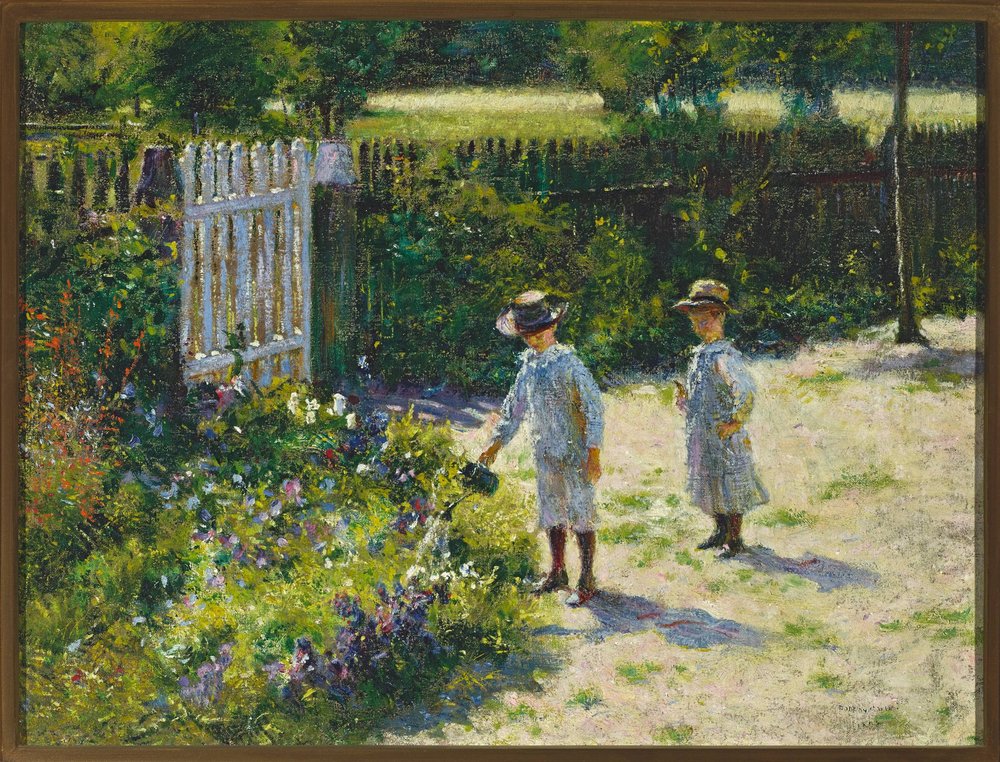The painting depicts a garden in the high summer - full of light, colourful flowers and pastel colours. In its central part we can see two children - an older boy with a watering can in his hand and a younger boy. They are both sons of Miłosz Kotarbiński. The six-year-old boy is Tadeusz Kotarbiński and the two-year-old one is his brother - Mieczysław. The artist immortalized both of them outdoors.
Could Podkowiński then have assumed that he was simultaneously portraying two children who will become important figures in the world of science and culture in their adult life? Certainly not.
Let's start from the beginning.
Tadeusz Marian Kotarbiński was associated with Warsaw where he was born on 31 March 1886. Young Tadeusz Kotarbiński grew up in an artistic environment. His father, Miłosz Kotarbiński was a painter, while his mother Ewa Koskowska (Kotarbińska) - was a pianist, though she also ran a guest house for some time.
Tadeusz's father, Miłosz Kotarbiński was a versatile artist. Apart from painting he also dealt with literary criticism, wrote poetry, sang and composed. Tadeusz's mother, Ewa Kotarbińska, nee Kostkowski, came from a landowning family. She was the daughter of an owner of a property in Chrzęsne (Wołomin county). After getting married Ewa and Miłosz moved to Warsaw where their first son, Tadeusz was born. The Kotarbiński family willingly spent summer months in the Koskowski property in Chrzęsne.
As Tadeusz Kotarbiński's father was a friend of Władysław Podkowiński, the latter used to visit Chrzęsne and its vicinity, where, as it is believed, the artist's most beautiful impressionist paintings were created. It was there that the 6-year-old Tadeusz and his brother, a 2-year-old Mieczysław were caught playing in the garden (1892) by Podkowiński.
Władysław Podkowiński used to observe and paint fragments of Masovian landscapes, later recognized as masterpieces of Polish art, over the years 1891 and 1892. "Children in the garden" is one of such paintings. The artist was already then familiar with the principles of impressionism, which he had come across before in the works of Claude Monet, Paris.
The researchers of Podkowiński's art believe that it was during the holidays spent in the Mazovian towns of Mokra Wieś and Chrzęsne that "the full assimilation of Parisian experiences, a synthesis of the principles of impressionist painting and observations of the native landscape" took place (among others Ewa Kossowska).
- In this painting the painter used his favourite cropping procedure in a close plan of the nature he was observing. Built diagonally, the painting was based on the contrast of green and yellow colours range, complemented with a grey-violet blue. He also managed to achieve the effect of a lyrical mood, created by skilfully distributed light - Elżbieta Charazińska, researcher of the artist's work.
It is said that Podkowiński, who was known for his great temperament, was unhappily in love with beautiful Ewa Kotarbińska, a wife of his friend Miłosz. This allegedly led to misunderstandings between them and made Podkowiński leave Chrzęsne.
The painting "Children in the garden" (dimensions 47 x 68 cm) is part of a collection of the National Museum in Warsaw. More information on the influence of French impressionists on the work of Władysław Podkowiński as well as on the painting itself can be learnt from audiodescription.
Kotarbińscy siblings
Tadeusz Kotarbiński, the oldest son of Zofia and Miłosz, had five younger siblings. In order of birth: Mieczysław, Janusz, Zofia, who died in early childhood, Kazimierz and Stanisław.
It's worth underlining that also two younger brothers of Teadusz were painters - Mieczysław and Janusz. Mieczysław Kotarbiński (immortalised by Podkowiński) was a professor of the Vilnius University, and later of the Academy of Fine Arts in Warsaw.
As a graphic, painter and metalworker, he designed badges of state orders (including the Order of the White Eagle and the Order of Polonia Restituta) and the Marshal's mace of Józef Piłsudski. Mieczysław Kotarbiński was murdered by the Germans during World War II. The younger, Janusz (who also died during World War II) was fascinated by the art of Podhale. He is, among others, the author of the polychrome and stained glass in the Holy Family Church in Krupowki Street in Zakopane.
Tadeusz Kotarbiński
The professor was a Polish philosopher, logician and ethicist. He was a representative of the Lvov-Warsaw School of philosophy, after World War II Tadeusz Kotarbiński moved to Lodz, where he became one of the founders of the University of Lodz and its first rector. One of the most famous works of Kotarbiński is the "Traktat o dobrej robocie" [A Treatise on Good Work] devoted to praxeology, i.e., the theory of efficient operation.
Prof. Tadeusz Kotarbiński is the patron of the Award established in 2015 by the University of Lodz for the best work in the field of humanities in Poland. Last week, the call for entries was launched. Books in the field of broadly understood humanities can be submitted until May 15 this year.
Edit: Promotion Centre, UL
Source: R. Kleszcz, "Tadeusz Kotarbiński. Sylwetka myśliciela." - wstęp do "Traktatu o dobrej robocie" [Tadeusz Kotarbiński. Silhouette of the thinker." - an introduction to the "Treatise on Good Work", Lodz University Press 2019 r., www.lubicki.art.pl

